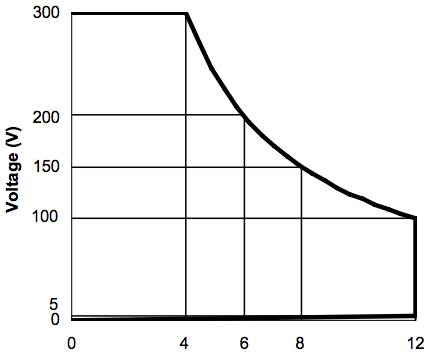Often the selection of programmable power supplies is based upon how high a voltage it can produce or how much current it can source. When selecting an electronic load, however, you need to consider not only volts and amps, but power as well.
For example, the SLH-500-6-1800 of the SLH Electronic Loads Series has a maximum input voltage of 500 VDC and a maximum input current of 6 Arms, but that doesn't mean that it can accommodate these voltages and currents under all conditions.
When specifying an electronic load for a particular application, you also have to look at the maximum power rating. In the case of the SLH-500-6-1800, that specification is 1,800 VA. From a practical point of view, what this means is that at 500 VDC, the maximum current that the SLH-500-6-1800 can sink is 3.6 A.
The power limit of any particular electronic load is given by its constant power curve. The power curve of the SLH-500-6-1800 is shown below.

A load must be selected so that the operating points are within the curve. For many applications in which different power sources are tested, there may be high voltage, low current requirements as well as low voltage, high current requirements. A single load may be able to handle both with good programming resolution. In cases where a single load may not work, the broad range of current, power and voltage available in the Programmable Power SL series allows optimum selection depending upon the voltage, current, and power required.
This brings us to the matter of model numbers. All of the models in Programmable Power's SL Series of electronic loads have model numbers that tell you the maximum voltage, maximum current, and maximum power dissipation of the unit. The first number gives the maximum voltage, the second number the maximum current and the third number the maximum power dissipation. In the case of the SLH-500-6-1800, that's 500 VDC, 6 A, and 1,800 VA.
Finally, a word about low-voltage operation. All SL series loads operate well below 1 V, but in many applications, such as fuel cell research and microprocessor voltage regulator modules (VRMs), the voltage at the load inputs can be 0.1 to 0.2V. This low voltage does not allow the load transistors to fully turn-on (bottom right corner of the power contour). To utilize the full rated current of an electronic load, a boost supply can be placed in series to increase the voltage. While a fixed voltage DC-DC converter can be used as the boost supply, a programmable power supply is preferred to keep the load voltage at the minimum to draw full current as the device under test ramps up in voltage.
For more information on electronic loads, contact AMETEK Programmable Power. You can send e-mail to sales.ppd@ametek.com or phone 800-733-5427.




